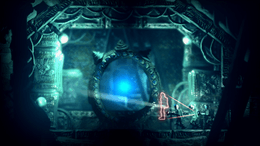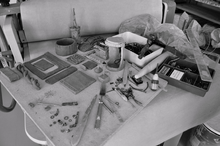The Swapper
| The Swapper | |
|---|---|
 | |
| Developer(s) | Facepalm Games Curve Studios (PS3, PSV, PS4, Wii U) |
| Publisher(s) | Facepalm Games |
| Writer(s) | Tom Jubert[1] |
| Platform(s) | |
| Release date(s) | Windows
Nintendo Wii U |
| Genre(s) | Puzzle-platformer |
| Mode(s) | Single-player |
| Distribution | Digital distribution |
The Swapper is a puzzle-platform video game for Microsoft Windows, Mac OS X and Linux. It was developed and published by Facepalm Games, a small independent company based in Helsinki, Finland.[2] Curve Studios later ported the game to Sony and Nintendo platforms in 2014.[3] In this science fiction-themed title, the player controls a female scavenger stranded aboard an abandoned research station, and discovers a strange device that allows them to create clones of themselves switching their consciousness between these clones. The player uses this ability to solve various puzzles and learn about the fate of the station's researchers.
The Swapper was released on May 30, 2013 to critical acclaim, with reviewers praising the game's visual style and atmosphere, the quality of the puzzles, and the game's ability to innovate on an already well established game mechanic.
Gameplay


The Swapper is a side-scrolling puzzle-platformer set in a science fiction universe. The player controls a person stranded on a damaged space station and looking for means to escape. To do so, they must explore the station and find orbs that are used to activate certain doors, allowing them to progress further into the game. The game uses some concepts of "Metroidvania" games in which the player may have to backtrack through the facility, divided into a number of rooms, to proceed within the game.[4]
The player acquires a hand-held cloning tool early in the game through which they solve puzzles to collect orbs. The tool offers two functions: the ability to create up to four simultaneous clones of the player character, and the ability to swap control to any of these clones as long as they are within line of sight. Once created, the clones will move with the player unless otherwise blocked by the environment; for example, if the player moves left, all the clones will also move left unless they run into a wall. This allows the player to complete complex steps to activate doors and switches as to acquire the orbs. Like the player, clones can also die falling from a large height or through other environmental hazards. Clones are reclaimed if they die or if they physically move into the same space as the player. When using the cloning tool, time slows down, allowing the player to execute more difficult maneuvers involving the clones. One example is to scale a vertical area by repeating the process of creating a clone higher than the currently active clone and immediately swapping control to the new clone while it is falling in mid-air, until a safe platform at the top of the area can be reached by a clone. Later levels include sections of the station where gravity has been reversed, increasing the difficulty of the puzzles.[4]
The cloning functionality is limited by certain light sources. Blue lights will prevent clones from being created in the illuminated area, while red lights will block the control swapping ability; purple lights block both actions. Touching certain white lights, moving off the current stage, or touching another clone will otherwise destroy those clones.[4]
Plot
Humanity has exhausted their natural resources, so seven remote outposts are established in distant space to extract and synthesise useful materials from their neighbouring planets, to send back to Earth. The crews of the space stations must survive independently off Earth for several decades. First Station 7 loses orbit and disintegrates into its closest sun, then Station 6 goes offline for unknown reasons.
When the crew of Theseus explore an uninhabitable desert planet called Chori V, with abundant natural mineral deposits, they find a more durable steel amalgam, an alien lifeform similar to Earth's silkworm, and highly complex rock formations of unknown origin. The rocks display unusual electro-chemical activity, leading some to believe they may possess rudimentary intelligence. The crew call these rocks 'The Watchers'.
Over time, the crew begins to notice that the rocks are penetrating their dreams, and come to believe that the rocks are telepathic. The scientists use what they learned from the rocks' electro-chemicals to create a device they call 'The Swapper'. They learn that this device creates clones of the user, and allows them to become the clone. A failed attempt at swapping two different people, which causes such massive memory loss as to make it impossible to know if either person was actually swapped, leads to a ban on person to person swapping. One of the crew, Dr. Chalmers, circumvents the ban by performing brain transplants on terminally-ill patients and keeping their brains alive. She believes she can use the swapper directly on the transplanted brains, and swap the person's consciousness into a body, prolonging their life. Her colleague, Dr. Dennett, disagrees with this practice on ethical grounds.
As time goes by and the scientists learn that the Watchers are millions of years old, they are believed to be much more intelligent than previously thought, perhaps even more intelligent than humans themselves.
The first Watcher to be found mysteriously resembles the shape of a human face, with eyes, a nose, mouth, and ornately carved decorations. It exhibits far more neurological activity than the other Watchers. The scientists hypothesise that it acts as a communications hub for the rest of the Watchers. They record radioactivity from the Head Watcher, but deem it safe enough for the crew to be around. However, members of the crew begin dying, and areas of the ship are deemed uninhabitable. The crew barricade themselves inside one area of the ship, thinking something must have followed them back from the planet surface. It soon becomes clear that the Watchers are causing the deaths. People report being able to hear the Watchers' thoughts. Those who do die shortly afterwards. By the time the crew realise the cause of the deaths, it is too late. They have brought on board so many hundreds of them, they would never be able to jettison them all into space and off the station.
Development

The Swapper was a project made by two University of Helsinki students Otto Hantula and Olli Harjola in their spare time.[5] The Swapper was backed by the Indie Fund, the 6th indie game title the fund has supported.[5] Rather than digital textures, the game features handcrafted art assets and clay which forms the various game levels.
Curve Studios helped to port the title to the PlayStation 3, PlayStation 4, and PlayStation Vita platforms, with an expected release date in May 2014.[6] After being delayed to ensure the PlayStation 3 and PlayStation Vita versions are "up to scratch", the game was released on 5 August 2014 in North America and the following day in Europe.[7] Curve Studios later announced that they will be bringing the game to Wii U, the graphical capability will be on par with PC version.[8][9] Subsequently, after the game's release on Wii U, Nintendo assisted in bringing The Swapper to the Japanese market, and they announced this during the Japanese version of the April 2015 Nintendo Direct presentation.
Reception
| Reception | ||||||||||||||||||||||
|---|---|---|---|---|---|---|---|---|---|---|---|---|---|---|---|---|---|---|---|---|---|---|
| ||||||||||||||||||||||
The Swapper received positive reviews from critics. It has an aggregate score of 88.70% on GameRankings and 87/100 on Metacritic.[10][11] The game has won numerous awards including Best International Game at Freeplay 2011 and Special Recognition Award at Indiecade 2011.[20]
References
- ↑ Harjola, Olli (31 July 2012). "Penumbra’s Tom Jubert hired for narrative design on The Swapper". Facepalm Games (Helsinki, Finland). Retrieved 7 December 2014.
- ↑ "About | Facepalm Games". Facepalm Games. Retrieved 1 June 2013.
- ↑ "The Swapper Wii U release date". October 15, 2014.
- ↑ 4.0 4.1 4.2 Machkovech, Sam (31 May 2013). "The Swapper review: Swap it to me". Ars Technica. Retrieved 3 June 2013.
- ↑ 5.0 5.1 Caoili, Eric (2012-03-01). "Indie Fund backing award-winning game The Swapper". Gamasutra. Retrieved 2013-06-01.
- ↑ Futter, Mike (2014-02-26). "The Swapper Cloning Itself On PS3, PS4, And Vita". Game Informer. Retrieved 2014-02-26.
- ↑ Hayden, Nicola (2014-06-30). "The Swapper will be invading all of your Sony consoles this summer". Push Square. Retrieved 1 July 2014.
- ↑ "The Swapper is Coming to Wii U". Kotaku. 2014-07-26.
- ↑ "Curve Studios Twitter". Retrieved 2014-07-26.
- ↑ 10.0 10.1 "The Swapper for PC - GameRankings". GameRankings. CBS Interactive Inc. Retrieved 1 June 2013.
- ↑ 11.0 11.1 "The Swapper for PC Reviews". Metacritic. CBS Interactive Inc. Retrieved 19 October 2013.
- ↑ http://www.metacritic.com/game/playstation-vita/the-swapper
- ↑ http://www.metacritic.com/game/playstation-4/the-swapper
- ↑ http://www.metacritic.com/game/wii-u/the-swapper
- ↑ Edge Staff (31 May 2013). "The Swapper review". Edge Magazine UK. Future Publishing Limited. Retrieved 1 June 2013.
- ↑ Ryckert, Dan (30 May 2013). "The Swapper". Game Informer. Game Informer Magazine. Retrieved 1 June 2013.
- ↑ Peele, Britton (30 May 2013). "The Swapper Review". GameSpot. CBS Interactive Inc. Retrieved 1 June 2013.
- ↑ Sliva, Marty (31 May 2013). "The Swapper: Review". IGN. IGN Entertainment, Inc. Retrieved 1 June 2013.
- ↑ Consiglio, Jorge (29 November 2014). "[Análisis] 'The Swapper'". ComboGamer (in Spanish). Retrieved 30 November 2014.
- ↑ "The Swapper". Facepalm Games. 2013-05-30. Retrieved 2014-02-15.
External links
| Wikimedia Commons has media related to The Swapper. |